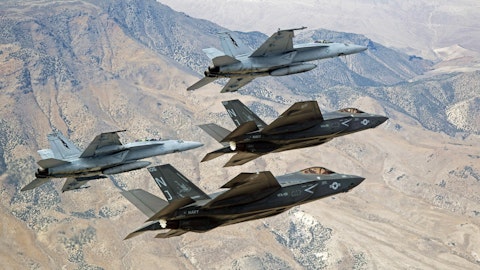Operator: Our next question comes from the line of Ken Herbert with RBC Capital Markets.
Ken Herbert: Chris, maybe just following up for Michelle on that comment and some of the comments on AJRD in the opening remarks, beyond some of the Defense Production Act opportunities, can you just talk about how you’re viewing CapEx across sort of legacy L3Harris and then more importantly, sort of AJRD as we think about 2024 and half of this year. And are you seeing a need to specifically sort of accelerate CapEx in AJRD to address some of the issues you outlined? And maybe how should we think about that as it relates to the growth in free cash next year?
Chris Kubasik: Yes. I’ll start it off and then ask Michelle to fill in. I mean we’re going to continue to prioritize our R&D and our CapEx based on business cases and based on needs. I think Aerojet Rocketdyne always had $50 million, $60 million of CapEx in their plan so that I don’t see any scenario where that would change or come down significantly. But we’ll look at it compared to all the other investments that we have. I think I’ve all been said, it’s a pretty high-growth market. and we’re trying to accelerate. So between the DPA money, which is over 200, the $50 million to $60 million annual CapEx, any other supplemental sources of funding we get sometimes from states and local municipalities. I think it all fits within our overall CapEx target and to the extent we need more, it will be at the expense of something else in the legacy portfolio that we don’t view is having the near-term need or the ROI.
So that’s kind of how I see it. There could be new markets down the road once we kind of catch up on this acceleration. And those will be case by case, but there’s a lot of exciting new technologies within Aerojet Rocketdyne, but the team is really focused on the backlog and the core business for now.
Michelle Turner: Yes. So I would just add in terms of your question, Ken, around free cash flow for next year. So to Chris’ comments, we do expect income to grow. So we think that, that will be a tailwind from an overall cash perspective. We expect some kind of nominal improvement in working capital. And then offsetting that, just as a reminder for everybody, our initial deal model on Aerojet assumed free cash flow accretion in year 2. So we expect there’ll be some kind of marginal impact just in totality of where they’re at in the program cycle. And then, on overall CapEx, we typically run around 2%. We’re not expecting any fundamental change in that level of investment as we go into next year.
Operator: Our next question is from the line of Matt Akers with Wells Fargo.
Matt Akers: I wanted to ask if you could touch on LHX NeXt a little bit. And specifically, just curious of the $500 million benefit that you called out, how much do you get to keep? Does any of that flow back to your customer or any other offsets we should think about?
Michelle Turner: Yes. Thanks for this question. I’m glad we’re getting to talk about it a little bit more. And so this is the next phase of our L3 and Harris merger evolution, if you will. And so if you think about the initial integration savings that we did as a company, several hundred million along with some offsets. This is the next phase of this, kind of the harder parts, if you will. And it’s really focused on leveraging our scale to drive efficiencies and also functional organization to ensure that we’re optimized for value creation. And so to your point specifically around the overall bottom-line impact, we do anticipate that there’s more investment that goes along with this phase of the journey, Matt. So you’ll see in our investor letter, we laid out about $400 million of investment.
And so you should think of this more as a nominal tailwind from a margin perspective and not flow it all to the bottom-line. But I do want to highlight a couple of tangible examples that the teams have already driven as we’re in the early stages of this, just so you can start to characterize what are we talking about, when we’re talking high level about LHX NeXt. And one of our recent wins, I’ll complement our HR team in [indiscernible]. They’ve done a fantastic job in renegotiating our employee benefit package, again, leveraging the scale of the new L3Harris portfolio to not only increase our benefits and also save on costs, but we’re also going to be holding our employee benefit cost flat to our employees. So this is really creating a win-win opportunity, both from a shareholder perspective, and our employees in terms of better benefits while maintaining the cost that they have to flow back to their families.
And then, on the organizational side of the equation, our comms team led by Tania Hanna has redesigned how we serve the company from a comms perspective and really focusing on the things that matter, right? And so, when you think about comms and how we send out external communications or internal communications, what are the things that are really going to move the needle from a value creation perspective in terms of our shareholders. And so they focused on streamlining our overall workflows, and we’ve actually reduced double digits the number of communications that we’re distributing as a result. So that gives you a little bit of color as to the things we’re looking at. But the biggest buckets, I would highlight here are really around the material opportunities, both on the direct side and the indirect side of the equation.
And so again, going back to — we’re in our fifth year as a company and truly leveraging the scale of L3Harris as a $35 billion market cap. And what we can bring to the table and negotiating with our suppliers has a real opportunity to drive value for our shareholders.
Operator: The next question comes from the line of Seth Seifman with JPMorgan.
Seth Seifman: Michelle, maybe another question for you. If you could talk about the path to the delevering and just kind of how much cash you need to have on the balance sheet. I think there’s probably some more debt coming up, then the company will have an ability to repay. So how do you think about what to term out versus what to repay now?
Michelle Turner: Yes. Thanks for this question as we want every opportunity, we can to highlight that we are focused on debt repayment. And so what are we going to focus on first? We’re going to focus on the commercial paper, the higher interest rates the variable rates, if you will. Where we sit today, post-acquisition, we’re at $13.5 billion, and our target by the end of the year is to get to about $13 billion of debt. And so from a leverage ratio perspective, we’re looking to be at 3.5 and our expectation is that we get below 3 over the next couple of years.
Operator: The next question comes from the line of Sheila Kahyaoglu with Jefferies.
Chris Kubasik: Rob, this will be our last question this morning.
Sheila Kahyaoglu: Just stepping back, big picture, your margins are 15% today. How do we think about expansion from here, is it possible? And then, to that extent maybe specifically on communication systems, can you talk about the puts and takes there? Can you shake off some of these supply chain issues? And how do you think about the improvement progress and just the core margin of that business and run away from here?
Chris Kubasik: Okay. I think I’ll take this one since it’s our last question, Sheila, and I guess you snuck in right under the wire here. So good morning. Yes, thanks for acknowledging the 15%, which I think are industry-leading margins, which we are quite, quite proud of. And even though they are industry leading, we are committed to find ways to continue to grow those margins. So on the CS side, we do have the commercial business model, which has played well for us. And that goes beyond just the tactical radios, we also have it at West Cam with our turrets and some of our sensors. So I think that’s just an area that we need to leverage. We’ve been increasing our prices to cover the dilutive effect of the cost increase. And I think that’s something that this industry doesn’t naturally do.




